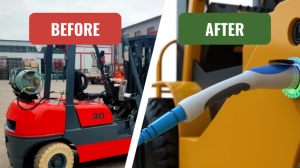There are many reasons why you may want to switch your forklift fleet from internal combustion to electric, including reduced emissions, lower operating costs, and a quieter work environment.
This article provides a clear guide for businesses planning to switch their forklift fleets from internal combustion to electric. It outlines key steps such as evaluating current operations, understanding financial impacts, and preparing your facilities for electric forklifts.

Assessing Your Readiness For Transition
When considering the shift to electric forklifts, it’s essential to thoroughly assess your operation’s readiness for the transition. This involves a multi-faceted evaluation, starting from analysing the current state of your fleet, understanding the financial implications, ensuring your facility’s infrastructure can support electric vehicles, aligning with environmental regulations, and preparing your workforce for this change.
Let’s dive into each of these areas to explore the necessary steps and considerations for a successful transition to electric forklifts.
Fleet Analysis:
In this step, closely review your existing fleet to determine which vehicles are suitable for replacement by electric models. This process should focus not only on the current condition and age of each forklift but also on their operational efficiency and how they meet your daily operational needs.
Consider factors like load capacity, usage frequency, and operating environment to ensure the selected electric models will match or enhance your current performance and demands.
Financial Considerations:
When analysing the financial aspect of transitioning to electric forklifts, you should consider both the initial investment and the long-term financial impacts. This includes the costs of purchasing or leasing electric forklifts compared to the cost of your current fleet, whether owned or leased.
Factor in the potential resale value of your current forklifts, the expected lifespan of electric models, and the operational cost differences, including maintenance and energy costs.
This comprehensive financial assessment will help balance the initial expenditure against the anticipated operational efficiencies and cost savings in the long run.
Infrastructure Suitability:
Evaluating your facility’s capacity to accommodate electric forklifts is crucial. This involves assessing if your current infrastructure can support the installation of charging stations, including their placement and accessibility.

Additionally, consider if electrical system upgrades are necessary to handle the increased power demand. It’s important to ensure that these modifications are feasible within your workspace, both in terms of physical space and electrical capacity, for a seamless transition to electric forklifts.
Read our guide on: Forklift Battery Charging Stations – Everything You Need To Know
Compliance and Sustainability:
In this step, you will examine how shifting to electric forklifts aligns with environmental benefits and ensures compliance with industry standards.
It’s about assessing the positive environmental impacts, like reducing emissions and enhancing air quality, and what this means for your business.
This is a crucial step in making a responsible and beneficial move towards a more sustainable operation.
Training and Workforce Adaptation:
In this phase, you should assess the training requirements of your staff not only to operate electric forklifts but also to manage their unique maintenance needs, like battery care and charging protocols.
It’s crucial to educate them on the correct procedures for battery maintenance and the safe handling of batteries and charging equipment.
The costs of training should also be considered when assessing the total cost of transition.
Planning Your Transition From IC to Electric Forklifts
Strategic Transition Plan
- Outline the comprehensive steps for transitioning to electric forklifts. Start with setting clear objectives and timelines, including milestones for purchasing, training, and full implementation.
- Make data driven decisions with the information gathered from assessing your readiness to transition.
- Develop a financial plan, considering costs and potential funding options.
- Engage with stakeholders to ensure buy-in and communicate the plan across your organisation at all levels.
- Finally, integrate a continuous review process to track progress and make adjustments as needed, ensuring a smooth and efficient transition.
Phased vs. Complete Overhaul
One of the first decisions you should make when planning your transition is whether to use a phased approach or go for a complete overhaul of your fleet. Here’s the advantages and disadvantages of each:
Phased Approach Advantages:
- Gradual Adaptation: More time for staff to adjust and for operations to adapt.
- Financial Flexibility: Costs are spread over time, easing potential budget impacts.
- Risk Mitigation: Allows for continuous learning and adjustments with each phase.
Phased Approach Disadvantages:
- Prolonged Transition: Full benefits of electric fleet are delayed.
- Operational Complexity: Managing two types of fleets simultaneously could add complexity.
Complete Overhaul Advantages:
- Immediate Benefits: Quick access to environmental and efficiency gains.
- Uniformity in Operations: Simplified training and maintenance.
Complete Overhaul Disadvantages:
- Higher Initial Investment: Significant upfront financial commitment.
- Operational Disruption: Potential challenges during the immediate switch, which may cause operational delays.
Vendor Selection and Partnership
Once you have a clear plan in place, selecting the right vendor is crucial. Your choice of vendor can significantly impact the success and efficiency of your transition.
Forkify is here to assist you in this crucial step. Simply submit your details through our “Search Deals” form, specifying that you’re undergoing a full fleet transition in the additional requirements section. We’ll leverage our network to match you with dealers equipped to fulfil your needs. They’ll reach out to you promptly to discuss the specifics of your transition. With Forkify’s support, you can streamline the vendor selection process and ensure a seamless transition to electric forklifts.
Find Your Perfect Forklift
Compare Quotes from Local Forklift Dealerships


Enter Requirements


We Find the Best Deal


Receive your Quote
Risk Management and Contingency Planning
This may be the most important step. Consider what happens if there are unexpected delays or issues. For example, if there’s a delay in the delivery of electric forklifts, have a plan for continuing operations with your current fleet.

In case of technical issues with the new forklifts, ensure you have access to prompt repair services or backup equipment. Also, consider the possibility of staff taking longer than anticipated to adapt to the new technology, and plan for additional training or support. Being prepared for these scenarios will help minimise disruption and maintain operational continuity throughout the switch.
Government Incentives For Switching To Electric Forklifts
Switching to electric forklifts can be very financially advantageous due to government incentives:
- Tax Credits and Rebates: Governments offer credits or rebates, reducing upfront costs.
- Grants and Funding: Funding programs cover purchase, installation, or operational expenses.
- Low-Interest Loans: Governments provide affordable financing options for electric vehicles.
- Exemption from Taxes and Fees: Electric forklifts may be exempt from registration fees and taxes.
- Infrastructure Support: Programs assist in installing charging infrastructure.
Additionally the government runs sustainability campaigns from time to time offering further benefits for transitioning to electric forklifts. The most recent of which was a 130% super deduction allowing companies to write off 130% of the cost of electric plant machinery, unfortunately this ended in May 2023 but it’s always worth checking to see if there are currently any additional incentives available.
Final Thoughts
Transitioning your forklift fleet to electric models requires careful planning and consideration of various factors, from fleet analysis to infrastructure suitability and financial assessments. By following the outlined steps and leveraging available government incentives, businesses can not only reduce emissions and operating costs but also contribute to a more sustainable operation.
Remember to continuously monitor progress, adapt as needed and use Forkify to find the perfect vendor to ensure a smooth and successful transition.
With proper planning and execution, converting to electric forklifts can have amazing long-term benefits for your business and the environment!